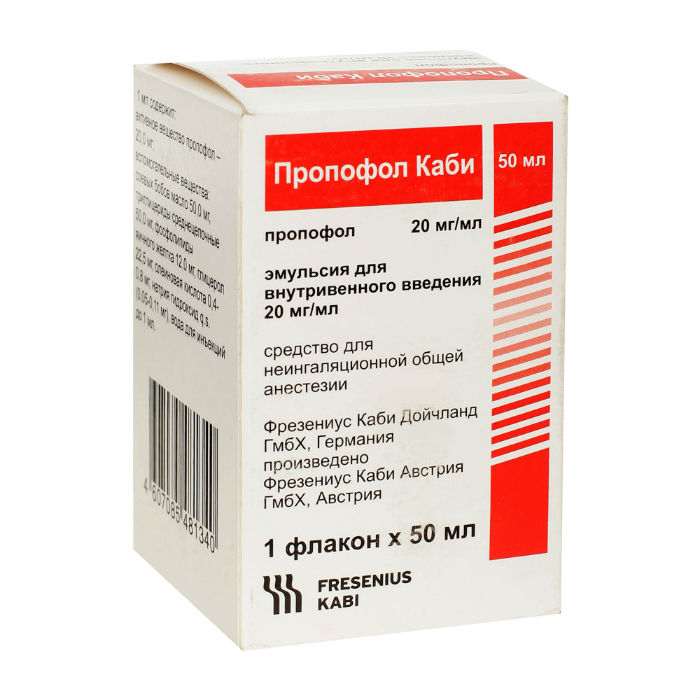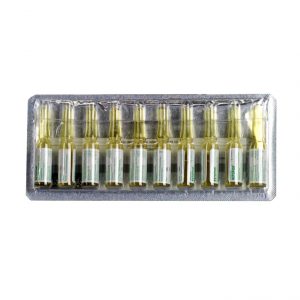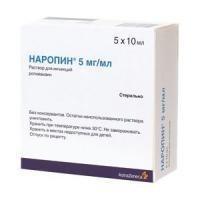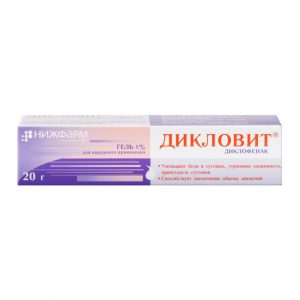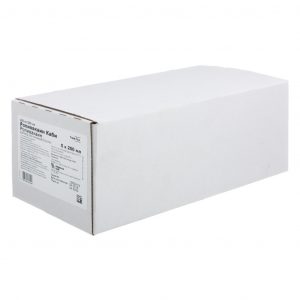Description
Release form
Emulsion for injection
Packing
Bottle 50 ml.
Pharmacological action
Propofol is a fast-acting intravenous anesthetic for the introduction and maintenance of general anesthesia, as well as for sedation of patients during intensive care.
The general consensus is that this anesthetic causes a non-specific effect at the level of lipid membranes. In most patients, general anesthesia occurs after 30-60 seconds.
The duration of anesthesia, depending on the dose and related drugs, is from 10 minutes to 1 hour. From anesthesia, the patient wakes up quickly and with a clear consciousness. The opportunity to open your eyes appears after 10 minutes. No specific adsorption sites have been established.
When using Propofol for induction of anesthesia and for maintaining it, a decrease in average blood pressure and small changes in heart rate are observed. However, hemodynamic parameters usually remain relatively stable while maintaining general anesthesia and the frequency of adverse hemodynamic changes is low.
Although respiratory depression may occur after administration of Propofol, any effects are qualitatively similar to those that occur when using other intravenous drugs for anesthesia, and are easily controlled in a clinical setting.
Propofol reduces cerebral blood flow, intracranial pressure and reduces cerebral metabolism. A decrease in intracranial pressure was significant in patients with an increased baseline value of intracranial pressure.
Indications
Propofol is used:
in adults and children older than 1 month for general intravenous anesthesia, with short-term effects of
in adults and children older than 1 month for induction of anesthesia and for maintaining
in adults and children over 16 years of age to provide a sedative effect receiving intensive care and being on mechanical ventilation
in adult conscious, in order to ensure a sedative effect during surgical and diagnostic procedures.
Contraindications
Hypersensitivity to one of the components of the drug, children up to 1 month old.
Propofol is contraindicated for sedation in patients under 16 years of age during intensive care.
Use during pregnancy and lactation
Contraindicated in pregnancy and lactation.
Special instructions
In cases where there is a likelihood of side effects associated with activation of the vagus nerve, it is advisable to administer an anticholinergic before intravenous anesthesia. Should not be used in obstetric practice.
The risk of pain along the vein can be significantly reduced by infusion through large veins or with the administration of a lidocaine solution.
Injection can only be done by specially trained personnel with the possibility of immediate use of mechanical ventilation, oxygen therapy, resuscitation in full.
Composition
Active ingredient: propofol – 20 mg.
Excipients: soybeans oil – 50 mg medium chain triglycerides – 50 mg egg yolk phospholipids – 12 mg glycerol – 22.5 mg oleic acid – 0.40.8 mg sodium hydroxide – qs (0.050.11 mg) water for injection – up to 1 m.
Dosage and administration
I / O, the dose is set individually.
General anesthesia for adults.
Introductory anesthesia: adults 20 40 mg every 10 s until signs of anesthesia appear. Patients under 55 years of age usually require from 1.5 to 2.5 mg / kg, older than 55 years and patients of ASA classes III and IV, especially with heart failure – the dose should be reduced to 1 mg / kg and the rate of administration ( 20 mg every 10 s). Children over 3 years old – slowly until clinical signs of anesthesia appear. The dose is adjusted in accordance with the age and (or) body weight of the child. For children over 8 years old, the likely dose is 2.5 mg / kg. Younger children may require a higher dose. Children of classes III and IV by ASA are recommended a lower dose. Not recommended for use in children under 3 years of age.
Maintenance of anesthesia: for adults – in the form of a continuous infusion or repeated bolus injection. With prolonged infusion, the dose is usually in the range of 6-12 mg / kg.
In elderly patients, patients with severe general condition, patients with ASA classes III and IV, and patients with hypovolemia, the dose is reduced to a minimum of 4 mg / kg / h. Bolus injected from 25 to 50 mg of the drug.
For children older than 3 years – in the form of a continuous infusion or bolus injection, usually satisfactory anesthesia is provided at a rate of administration of 9-15 mg / kg / h.
Achieving a sedative effect: during intensive care, patients undergoing mechanical ventilation are advised to continue infusion at a rate of 0.3 0.4 mg / kg / h for diagnostic and surgical procedures, depending on the clinical picture, usually 0.5 1 mg for 1 5 min to achieve the effect and 1.5 4.5 mg / kg / h for maintenance. To quickly achieve a deep sedative effect – 10 20 mg bolus.
Do not use in children under 16 years of age with surgical and diagnostic procedures to achieve a sedative effect.
The drug should not be used during pregnancy and during lactation, as well as as an anesthetic in obstetrics.
Do not mix with other injectable solutions except 5% glucose solution, lidocaine solution for injection, fentanyl solution for injection.
Side effects
decreased blood pressure,
bradycardia (sometimes severe),
short-term respiratory failure,
shortness of breath.
Rarely:
convulsions,
opistotonus,
pulmonary edema.
Drug Interactions
Compatible with medications for spinal and epidural anesthesia, with medicines used in premedication, muscle relaxants and analgesics.
Storage conditions
Do not store above 25 ° C.
Do not freeze!
Expiration
3 years.
active substance
Propofol
Conditions of sale from drugstores
Prescription
lekarstvennaja form
Ñmulsyya for infusions
Fresenius Kabi, Germany
